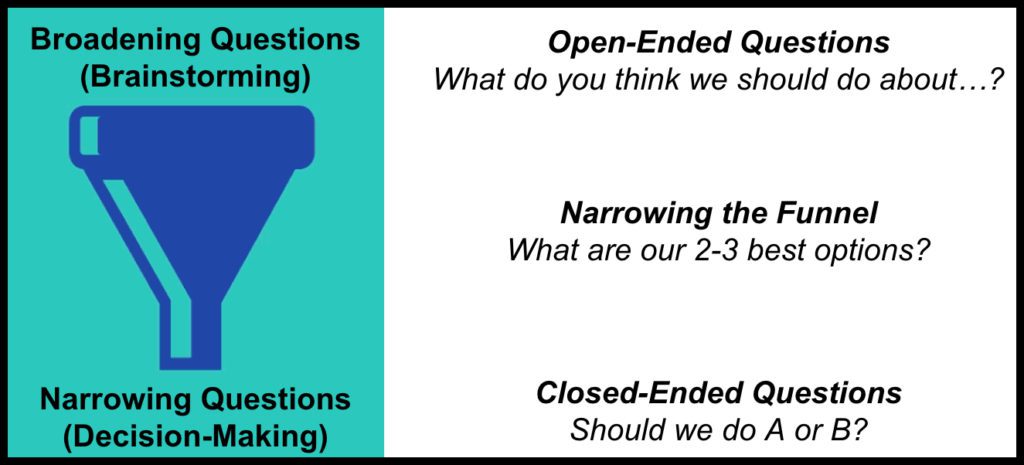This Slight Tweak in the Way You Ask Questions Can Make Your Meetings 2X as Productive
After I finished facilitating a meeting a few years ago, my boss asked if I could stay in the conference room for a few minutes so he could give me some feedback.
I’m usually pretty good at hearing tough messages, but I’m sure my blood pressure still spiked. I had no idea what my manager would say.
The purpose of the meeting had been to discuss the results of a recent engagement survey and decide what to do with the survey feedback. My manager explained that I had asked good questions during the brainstorming portion at the start of the meeting, but I had made a big mistake at the end of the meeting.
After the group had expressed their thoughts and we had moved on to generating solutions, I asked a question that brought us back into our initial brainstorming mode. In other words, we had moved from step 1 to step 2 to step 3, then—with five minutes left in the meeting—I brought us all the way back to step 1.
He explained that there’s a big difference between questions that broaden the funnel of conversation versus questions that narrow that funnel.
Broadening questions are generally open-ended questions that generate a lot of ideas. They’re powerful in brainstorming exercises or early in meetings because they invite participants to share their ideas. They’re designed to be divergent (generating many different ideas).
Narrowing questions are more specific queries that converge people around a solution or a path forward. They are best used when you’re trying to move people toward making a decision or determining action items. They’re designed to be convergent (coalescing around a shared solution).

I had done a good job of asking brainstorming questions at the start of the meeting. The questions I posed early in the meeting helped generate a healthy group discussion:
- What most surprised you about this survey data?
- What were the biggest themes you noticed?
- What do you think we should do about X?
Team members shared ideas freely and—by the end of our brainstorming—we had a bunch of observations, takeaways, and ideas to consider.
But then I made a classic mistake. Rather than wrapping up and converging on what we were going to do next, I jumped back up to the top of the funnel and started to ask more broadening questions.
Because of my mistake, we ended the meeting late and didn’t conclude with tangible next steps.
The Takeaway
Since that meeting, I’ve become much more mindful of the types of questions I ask during meetings. I’ve gotten the opportunity to host hundreds of meetings and put this concept into practice.
I’ve found that the group discussion goes to VERY different places depending upon whether I ask broad or narrow questions. Neither type of question is better than the other. The key is knowing when to use each.
As a meeting facilitator, it’s important to recognize where you are in a conversation: Is this the time to go broad or narrow? Do we have enough ideas to move forward and choose what to focus on? Based on the amount of time left in this meeting, should I start asking more closed-ended questions that push the group to make a decision?
If you’re scheduled to facilitate any meetings next week, I encourage you to thoughtfully consider when to use broad questions versus narrow ones.
This simple concept will immediately make your meetings much more efficient, effective, and productive.




